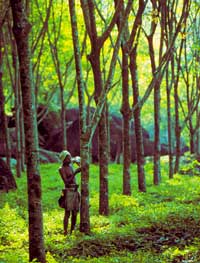03 Jul 2012 - {{hitsCtrl.values.hits}}
 Rubber has been grown traditionally in the Low Country Wet Zone covering the Southwestern, Southern and Central parts of Sri Lanka, though the low and mid elevations in the Intermediate and Dry Zones are also being explored now with varying degrees of success. This tract is however, now reaching a level of saturation for rubber cultivation and the scope of further expansion is very much limited. Therefore, it has become necessary to look for new locations to plant rubber.
Rubber has been grown traditionally in the Low Country Wet Zone covering the Southwestern, Southern and Central parts of Sri Lanka, though the low and mid elevations in the Intermediate and Dry Zones are also being explored now with varying degrees of success. This tract is however, now reaching a level of saturation for rubber cultivation and the scope of further expansion is very much limited. Therefore, it has become necessary to look for new locations to plant rubber. Soil related factors should, therefore, be considered as having a very important bearing on crop performance and crop productivity on different kinds of soils occurring within the same agro-ecological region. Meaningful land use planning for plantation agriculture, therefore, should be based on a proper understanding of the soil-vegetation relationships.
Soil related factors should, therefore, be considered as having a very important bearing on crop performance and crop productivity on different kinds of soils occurring within the same agro-ecological region. Meaningful land use planning for plantation agriculture, therefore, should be based on a proper understanding of the soil-vegetation relationships.
26 Nov 2024 47 minute ago
26 Nov 2024 2 hours ago
26 Nov 2024 3 hours ago
26 Nov 2024 4 hours ago
26 Nov 2024 4 hours ago